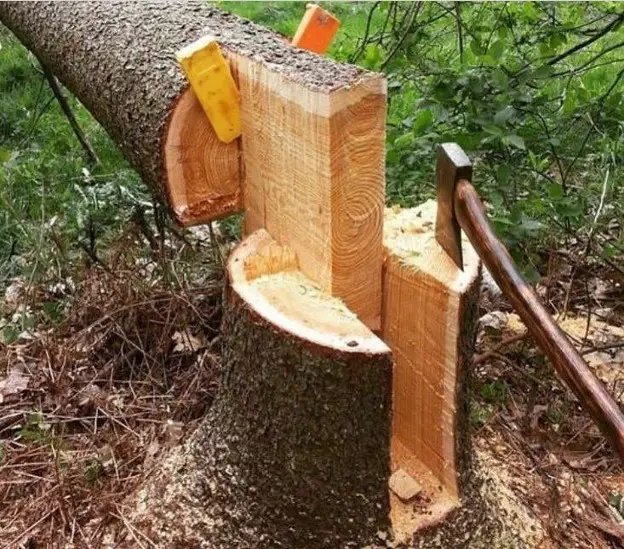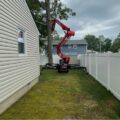There are a huge number of tree cutting techniques, and in this article, we will look at the main ones.
TREE CUTTING TECHNIQUES: MANUAL
Recognize and think of a safe but workable feeling scheme based on visual observation.
Pay attention to all relevant factors: the area where the trees are planted, where the wind blows, where the trees are inclined, what species they are, and what terrain features they have.[/color-box]
Check the quality of sharpening of the chain teeth. If they are blunt, it is necessary to sharpen them before sawing the tree. It is recommended to do it with a file. It’s important to use safe tools and tree removal equipment.
![Tree Cutting Techniques - Detailed Manual Tree Cutting Techniques - 9+Best Detailed Manual [2021]](https://treecuttinginfo.com/wp-content/uploads/2021/02/Tree-cutting-techniques_001.jpeg)
Check the tension of the chain. If the chain is loose, it needs to be tightened.
Make sure there is enough fuel mixture in the tank. If there’s less than half a tank in the tool, it might be better to top up the tool.
Calculate the path the tree will take and clear the area. If the tree being felled leans and gets caught in neighboring limbs and branches, it will be very difficult to bring it down.
Clear an area near the wood so that you have unobstructed access to it.
Get all the tools you need for felling, which include an ax, a mallet, and a hammer.
Cut a notch using the “open face” or “undercut” method as described in the OSHA Logging Standard 29 cfr 1910.266(g) (2) (iii), making the selection based on tree species, size, lean, location, and safety.
Carefully consider the cutting pattern in order to ensure safety during work.
After a warning, which must be clearly understood by absolutely everyone in the area, carry out the cutting back.
Establish the proper hinge wood (length—approximately 80% of diameter breast height [DBH], width – approximately 10% DBH). This will help keep control of the direction the tree will fall and minimize accidental injury while logging. Always keep the tree in sight and retreat a minimum of twenty feet while clearly adhering to the constructed evacuation pattern.[/color-box]
TREE CUTTING TECHNIQUES: PROPER TIMBER FELLING PROCEDURES
![Tree Cutting Techniques - Detailed Manual Tree Cutting Techniques - 9+Best Detailed Manual [2021]](https://treecuttinginfo.com/wp-content/uploads/2021/02/Tree-cutting-techniques_002.jpg)
- Get rid of or just avoid all snags or roots.
- Always pay attention to treetops for widows, other trapped trees, wires, and other perceived hazards. The plan right away which way the tree will fall. Before you start cutting, get rid of everything unnecessary in the area around the tree.
- Immediately prepare a line for yourself, on which you will retreat. It should be forty-five degrees from the fall line. Make sure there is nothing unnecessary on the line and you won’t fall or get stuck somewhere along the way.
- Before you start pruning, make sure no one is closer than two tree lengths from where you cut.
- Make a small cut on all the trees. Pay no attention to the diameter.
- Give a warning beforehand with a special shout, which all workers know, before starting to cut back or finally cut down a tree.
- Never cut a standing tree completely at once. Leave just the right amount of wood between the notch and the back cut to allow the tree to take hold. If you don’t do this, you won’t be able to control the tree’s fall and it will simply fall on you.
- If you leave too many hinges, the tree can collapse or split. The minimum consequence of this is a decrease in the value of the log, and the maximum is injury or death to the feller.
- Never leave any trees stuck or hanging. Remove, push or pull them with a skidder or other tools. If you have to move away from a tree indefinitely, leave a mark on the tree to indicate that it is dangerous to stay in that area.
- Do not trim your tree on days when strong, gusty winds are blowing.
- Never climb a tree to get rid of areas of jammed trees.
- Never leave stuck pieces of wood behind, as any vibration from your tools or a sudden strong wind could bring that piece down on your head when you don’t suspect anything.
- Try to keep the wood falling on cleaned areas.
- Retreat from the falling tree at a forty-five-degree angle in the opposite direction of the direction of fall for a distance of about twenty feet. It is advisable to mark another tree at the end of the retreat line to stand behind. It is much safer that way.

PROPER FELLING IMPROVES QUALITY, QUANTITY, AND SAFETY BY REDUCING:
- The number of trees that fall in the wrong direction
- Number of trees hanging from branches
- Fiber elongation and lateral cuts
- Whether there is damage to the trunk
- The amount of time that has been spent moving the wood to plant
- The amount of time that has been spent pulling trees for planting
- The amount of time that could be lost when the chainsaw is pinched in the tree trunk
- Anticipated injuries from simultaneous pushing and sawing
- Chance of splitting the tree if not handled properly
- Number of wood butts pushing away from the stump
- The chance of the tree is almost completely cut but not falling off.
PROPER DIMENSIONS OF NOTCHES
The depth of the notch should be a third of the diameter of the tree. The end notch opening A is directly proportional to the depth B.
![Tree Cutting Techniques - Detailed Manual Tree Cutting Techniques - 9+Best Detailed Manual [2021]](https://treecuttinginfo.com/wp-content/uploads/2021/02/joxi_screenshot_1613208277282.png)
![Tree Cutting Techniques - Detailed Manual Tree Cutting Techniques - 9+Best Detailed Manual [2021]](https://treecuttinginfo.com/wp-content/uploads/2021/02/joxi_screenshot_1613208324707.png)
![Tree Cutting Techniques - Detailed Manual Tree Cutting Techniques - 9+Best Detailed Manual [2021]](https://treecuttinginfo.com/wp-content/uploads/2021/02/joxi_screenshot_1613208378740.png)
![Tree Cutting Techniques - Detailed Manual Tree Cutting Techniques - 9+Best Detailed Manual [2021]](https://treecuttinginfo.com/wp-content/uploads/2021/02/joxi_screenshot_1613208481593.png)
OPEN-FACE NOTCH (70◦ OR MORE)
Make a cut into which you can install a hinge, and cut toward the back of the selected tree. Finish the cut. You need to keep enough wood on the backside of the tree. Then release the wood from the backside of the tree. This can be done by making a kerf under the kerf.
![Tree Cutting Techniques - Detailed Manual Tree Cutting Techniques - 9+Best Detailed Manual [2021]](https://treecuttinginfo.com/wp-content/uploads/2021/02/joxi_screenshot_1613208584582.png)
RESULTS OF IMPROPER BACK CUTTING
![Tree Cutting Techniques - Detailed Manual Tree Cutting Techniques - 9+Best Detailed Manual [2021]](https://treecuttinginfo.com/wp-content/uploads/2021/02/joxi_screenshot_1613208633001.png)
BACK CUT TOO DEEP (INADEQUATE HINGE)
![Tree Cutting Techniques - Detailed Manual Tree Cutting Techniques - 9+Best Detailed Manual [2021]](https://treecuttinginfo.com/wp-content/uploads/2021/02/joxi_screenshot_1613208754342.png)
BACK CUT TOO HIGH ABOVE THE NOTCH
![Tree Cutting Techniques - Detailed Manual Tree Cutting Techniques - 9+Best Detailed Manual [2021]](https://treecuttinginfo.com/wp-content/uploads/2021/02/joxi_screenshot_1613208785946.png)
BACK CUT BELOW THE NOTCH
![Tree Cutting Techniques - Detailed Manual Tree Cutting Techniques - 9+Best Detailed Manual [2021]](https://treecuttinginfo.com/wp-content/uploads/2021/02/joxi_screenshot_1613208814994.png)
SLOPING BACK CUT
![Tree Cutting Techniques - Detailed Manual Tree Cutting Techniques - 9+Best Detailed Manual [2021]](https://treecuttinginfo.com/wp-content/uploads/2021/02/joxi_screenshot_1613208851502.png)
ANGLE-BACK CUT WITH INADEQUATE NOTCH
![Tree Cutting Techniques - Detailed Manual Tree Cutting Techniques - 9+Best Detailed Manual [2021]](https://treecuttinginfo.com/wp-content/uploads/2021/02/joxi_screenshot_1613208883035.png)
FELLING PROBLEM TREES WHEN USING TREE CUTTING TECHNIQUES
Some trees may have other problems during cutting:
- If the tree has scars on the side, it will be easy to cut.
- An example of such a tree is the ash tree.
- Large and massive trees are light slender or heavy tops.
- Heavy slender tops.
WARNING:
Several of the following methods of felling trees against the natural slope may or may not require lateral cutting on the surface at all angles of the notch when cutting logs of assortments. Side-cutting is usually used on trees with support to prevent barber’s chair. Such feeling is most common on straight-grained trees.
Examples of such trees are oak and ash. In this case, lateral log cutting is strictly mandatory and cannot be ignored. Why is this procedure important? It will help to reduce the number of lateral scars and the pulling of trunk fibers.
However, there is a downside to this method. It significantly reduces the amount of strength of the holding log or joint, so be extremely careful.
TREES THAT SIDE SCAR EASILY
In order to get rid of side scars in conventional felling, the sides of the hinge are lightly sawed between the notch and back kerf before starting the back kerf procedure. As the wood begins to lurch and fall, the more resistant and bent fibers stop breaking as the notch closes. Instead of breaking the hinge, the lines on the sides of the tree will rip out the trunk, resulting in scars.
![Tree Cutting Techniques - Detailed Manual Tree Cutting Techniques - 9+Best Detailed Manual [2021]](https://treecuttinginfo.com/wp-content/uploads/2021/02/joxi_screenshot_1613209005217.png)
THE WAY YOU CAN USE WHEN THE SIZE OF THE TREE IS LARGER THAN THE LENGTH OF THE CHAINSAW BLADE, BUT NOT MORE THAN TWICE THE LENGTH OF THE BLADE
![Tree Cutting Techniques - Detailed Manual Tree Cutting Techniques - 9+Best Detailed Manual [2021]](https://treecuttinginfo.com/wp-content/uploads/2021/02/joxi_screenshot_1613209310899.png)
Once the wood is on either side of the top of the bar, the saw becomes abruptly straight, and the hole will end slightly beyond the center of the wood’s diameter. We then saw all the way through, leaving only the supporting wood. We do the same thing on the other side of the tree.
Pull out the saw and make a cut to help release it on the opposite side of the tree you have selected for felling.
Note: If suddenly the boring is not done as planned, you will dramatically increase the chances of kickback, so it is worth being very careful in this case. Do not lose your attention.
Be warned: When using this method, the saw must be turned on to the maximum rpm available and the chain must be properly sharpened before doing so. For the correct use of this method we recommend you to have special training.
USE IF THE DIAMETER OF THE TRUNK IS MORE THAN TWICE THE LENGTH OF THE CHAIN SAW
![Tree Cutting Techniques - Detailed Manual Tree Cutting Techniques - 9+Best Detailed Manual [2021]](https://treecuttinginfo.com/wp-content/uploads/2021/02/joxi_screenshot_1613209540337.png)
- We make the notch according to the standard procedure. We make the hole in the very center of the cut with the lower section of the top of the bar.
- You need to cut the amount of wood that is necessary for the bar to reach well on both sides. Pull out the saw.
Start making the cut in the standard step for the backsplash. Again use the lower quadrant of the guide bar for this. - Drill straight ahead. Remember to leave the necessary wood for the hinge, guided by the dimensions of the wood itself. Slightly swipe the saw backward.
- Saw through about half of the trunk. Leave the necessary amount of wood that can hold the tree together.
- Follow exactly the same plan on the opposite side of the tree trunk.
- Make a free cut on the opposite side.
Be warned: this is a very highly specialized type of feeling. The huge-diameter barrel can be left for a while. It can stand until the cutter has the opportunity to use a larger saw with a longer bar. Please note that this technique requires special training and preparation before it can be done.
HEAVY LEANERS
![Tree Cutting Techniques - Detailed Manual Tree Cutting Techniques - 9+Best Detailed Manual [2021]](https://treecuttinginfo.com/wp-content/uploads/2021/02/joxi_screenshot_1613209724242.png)
- Start your work by notching on the open side. Observe the length of the hinges at eighty percent DBH.
- At the same level as the notch, cut the wood out of the hinge wood. Leave just the right amount of wood to keep the wood from falling prematurely. Remember to start drilling from the bottom tip of the bar. This is safest because it is a proven method
- Then on the other side, you also do the boring. You need to make sure that the two cuts end up overlapping. If the trunk is small in diameter, you can safely ignore this step, because in this case, one kerf will be quite enough for you.
- The final straight horizontal kerf is made under the boring kerf. Hold the wood carefully and let it fall, guiding and controlling it with the triple hinge.
Be warned: This tree cutting method is for real professionals. If you don’t know anything about it, don’t take it on.
FELLING AGAINST THE NATURAL LEAN
A very large tree can be cut down against its natural inclination with this technique. To begin, still engage the notch with an open surface and drill the tree to place the hinge there. By no means cut out the back. Give the wood just the right amount of wood at the back for safety.
Take the saw out and put wedges in the slot. Next, release the wood from the back. Complete the technique by jamming the trunk flat. As a reminder, this technique is also for experienced woodcutters.
![Tree Cutting Techniques - Detailed Manual Tree Cutting Techniques - 9+Best Detailed Manual [2021]](https://treecuttinginfo.com/wp-content/uploads/2021/02/joxi_screenshot_1613209815603.png)
SAFETY INSTRUCTIONS FOR TREE FELLING TECHNIQUES
- Make sure you are standing firmly and always keep your balance.
- Always start pruning from the backside of the tree and work your way up.
- Always be on the uphill side of the tree.
- Be sure to go around the ground with your limbs, you don’t want to climb the tree rashly.
- If at all possible, stand with your feet in the gap and saw from the left side of the tree.
- Before you start, check that the chain brake is engaged and that the bar is in the right place.
- Make sure the saw is set to its maximum speed before cutting limbs.
- Stay at least two trees away from other felling operators and always maintain this distance.
- Use a limb-locking technique: the second cut should go slightly around the first.
- Check the condition of auxiliary aids and tools before starting work. Blunt, defective auxiliary aids and tools must not be used.
- When carrying the tool from one place to another, its power must be turned off.
Video: Tree Cutting Techniques
In this video, you will see the awesome fastest tree felling technique and dangerous fastest biggest tree felling cutting down.

![Tree Cutting Techniques - Detailed Manual Tree Cutting Techniques - 9+Best Detailed Manual [2021]](https://treecuttinginfo.com/wp-content/uploads/2021/02/TREE-CUTTING-TECHNIQUES.png)



